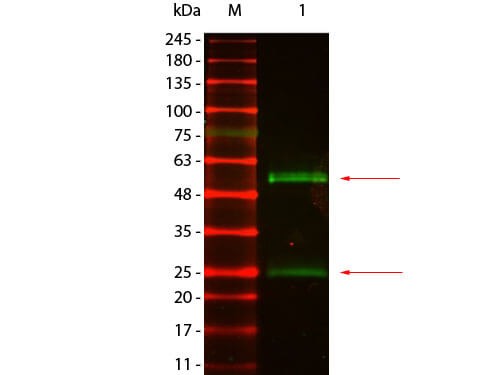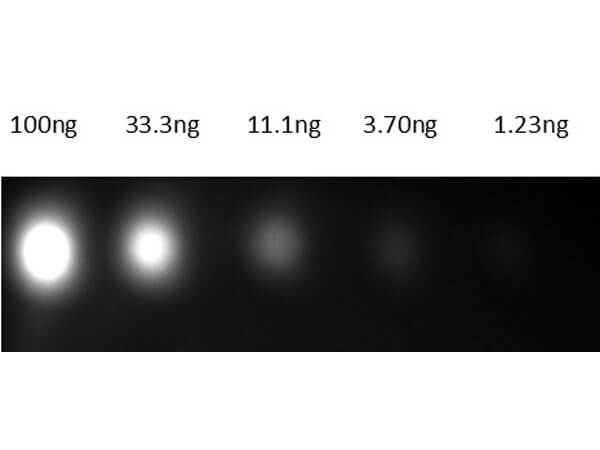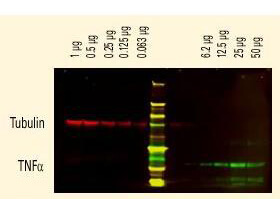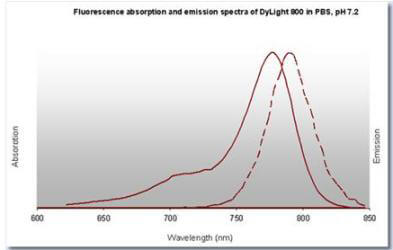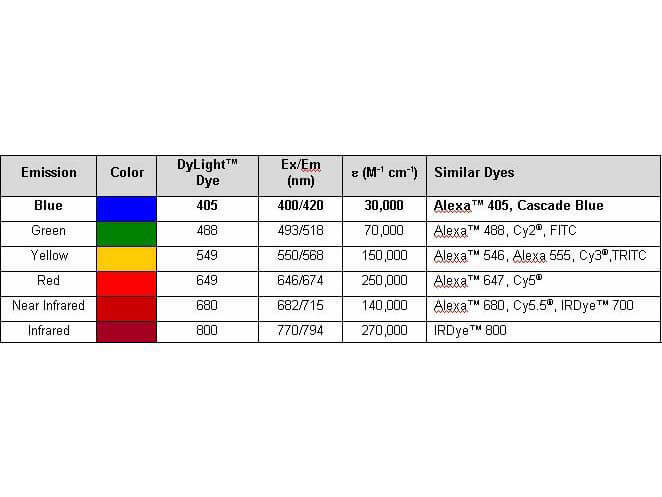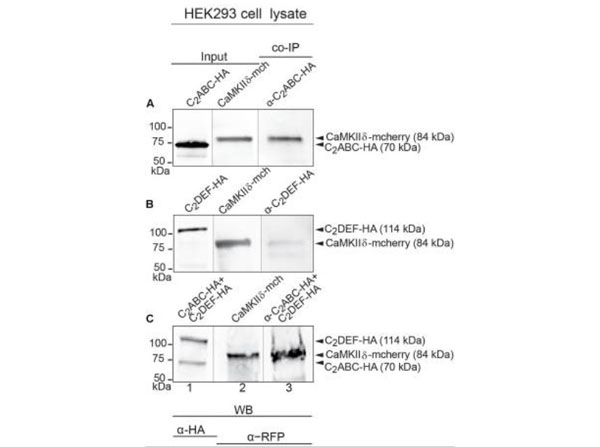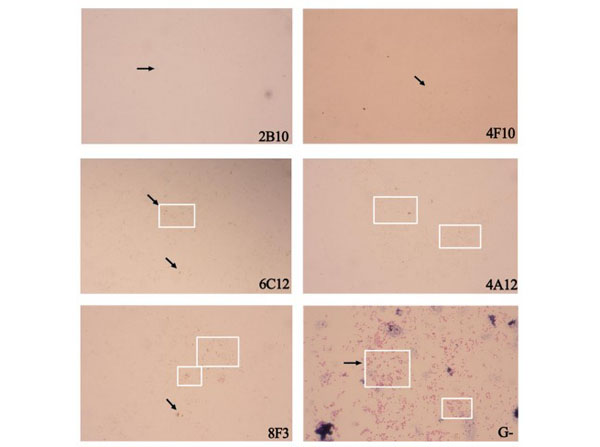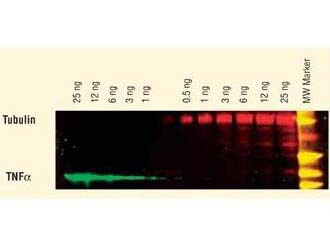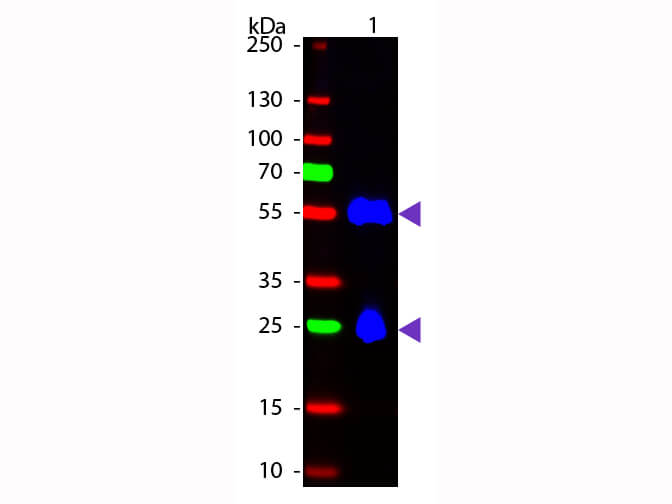Mouse IgG (H&L) Antibody DyLight™ 800 Conjugated Pre-Adsorbed
Goat Polyclonal
29 References
610-145-121
100 µg
Lyophilized
WB, IF, Dot Blot
Mouse
Goat
Shipping info:
$50.00 to US & $70.00 to Canada for most products. Final costs are calculated at checkout.
Product Details
Goat Anti-Mouse IgG (H&L) Antibody DyLight™ 800 Conjugated (Min X Bv Ch Gt GP Ham Hs Hu Rb Rt & Sh Serum Proteins) - 610-145-121
Goat Anti-Mouse IgG Secondary Antibody DyLight™800 Conjugated, Goat Anti-Mouse IgG Antibody DyLight™800 Conjugated, Anti-mouse IgG secondary antibody, anti-mouse IgG DyLight™800 conjugated secondary antibody
Goat
IgG (H&L)
DyLight™ 800
Polyclonal
IgG
Target Details
Mouse
Mouse IgG whole molecule
This product was prepared from monospecific antiserum by immunoaffinity chromatography using Mouse IgG coupled to agarose beads followed by solid phase adsorption(s) to remove any unwanted reactivities. Assay by immunoelectrophoresis resulted in a single precipitin arc against anti-Goat Serum, Mouse IgG and Mouse Serum. No reaction was observed against Bovine, Chicken, Goat, Guinea Pig, Hamster, Horse, Human, Rabbit, Rat and Sheep Serum Proteins. This antibody will react with heavy chains of mouse IgG and with light chains of most mouse immunoglobulins.
Application Details
Dot Blot, WB
IF
- View References
Anti-Mouse IgG DyLight 800 Antibody has been tested by dot blot and western blot and is designed for immunofluorescence microscopy, fluorescence based plate assays (FLISA) and fluorescent western blotting. This product is also suitable for multiplex analysis, including multicolor imaging, utilizing various commercial platforms. The emission spectra for this DyLight™ conjugate match the principle output wavelengths of most common fluorescence instrumentation.
Formulation
1.0 mg/mL by UV absorbance at 280 nm
0.02 M Potassium Phosphate, 0.15 M Sodium Chloride, pH 7.2
0.01% (w/v) Sodium Azide
10 mg/mL Bovine Serum Albumin (BSA) - Immunoglobulin and Protease free
100 µL
Restore with deionized water (or equivalent)
Shipping & Handling
Ambient
Store vial at 4° C prior to restoration. For extended storage aliquot contents and freeze at -20° C or below. Avoid cycles of freezing and thawing. Centrifuge product if not completely clear after standing at room temperature. This product is stable for several weeks at 4° C as an undiluted liquid. Dilute only prior to immediate use.
Expiration date is one (1) year from date of receipt.
Anti-Mouse IgG DyLight 800 Antibody generated in goat detects reactivity to Mouse IgG. Secreted as part of the adaptive immune response by plasma B cells, immunoglobulin G constitutes 75% of serum immunoglobulins. Immunoglobulin G binds to viruses, bacteria, as well as fungi and facilitates their destruction or neutralization via agglutination (and thereby immobilizing them), activation of the compliment cascade, and opsonization for phagocytosis. The whole IgG molecule possesses both the F(c) region, recognized by high-affinity Fc receptor proteins, as well as the F(ab) region possessing the epitope-recognition site. Both the Heavy and Light chains of the antibody molecule are present. Secondary Antibodies are available in a variety of formats and conjugate types. When choosing a secondary antibody product, consideration must be given to species and immunoglobulin specificity, conjugate type, fragment and chain specificity, level of cross-reactivity, and host-species source and fragment composition.
García-Poyatos C et al. (2024). Cox7a1 controls skeletal muscle physiology and heart regeneration through complex IV dimerization. Dev Cell.
Applications
WB, IB, PCA
Cantacorps L et al. (2024). Developmental metformin exposure does not rescue physiological impairments derived from early exposure to altered maternal metabolic state in offspring mice. Mol Metab.
Applications
WB, IB, PCA
Zhou Y et al. (2023). Targeting of HBP1/TIMP3 axis as a novel strategy against breast cancer. Pharmacol Res.
Applications
WB, IB, PCA
Yang R et al. (2023). The transcription factor HBP1 promotes ferroptosis in tumor cells by regulating the UHRF1-CDO1 axis. PLoS Biol.
Applications
IF, Confocal Microscopy
Tapia-Galisteo A et al. (2022). Trispecific T-cell engagers for dual tumor-targeting of colorectal cancer. Oncoimmunology.
Applications
WB, IB, PCA
Zhang H et al. (2022). Pharmacological suppression of Nedd4-2 rescues the reduction of Kv11.1 channels in pathological cardiac hypertrophy. Front Pharmacol.
Applications
WB, IB, PCA
Xu S et al. (2021). IL-6 promotes nuclear translocation of HIF-1α to aggravate chemoresistance of ovarian cancer cells. Eur J Pharmacol.
Applications
Undefined
Cao Z et al. (2021). HBP1-mediated transcriptional repression of AFP inhibits hepatoma progression. J Exp Clin Cancer Res.
Applications
WB, IB, PCA
Liu Y et al. (2021). GP73-mediated secretion of AFP and GP73 promotes proliferation and metastasis of hepatocellular carcinoma cells. Oncogenesis.
Applications
WB, IB, PCA
Woods BL. et al. (2020). Interplay of septin amphipathic helices in sensing membrane-curvature and filament bundling. bioRxiv
Applications
WB, IB, PCA
Navarro R et al. (2020). TGF‐β‐induced IGFBP‐3 is a key paracrine factor from activated pericytes that promotes colorectal cancer cell migration and invasion. Mol Oncol.
Applications
WB, IB, PCA
Kennedy T et al. (2020). Genetic background mutations drive neural circuit hyperconnectivity in a fragile X syndrome model. BMC Biol.
Applications
IF, Confocal Microscopy
Owusu-Brackett N, Zhao M, Akcakanat A, et al. (2020). Targeting PI3Kβ alone and in combination with chemotherapy or immunotherapy in tumors with PTEN loss. Oncotarget.
Applications
WB, IB, PCA
Asthana V et al. (2020). Development of a Novel Class of Self-Assembling dsRNA Cancer Therapeutics: a Proof of Concept Investigation. Mol Ther Oncolytics.
Applications
WB, IB, PCA
Mitra S, Bodor DL, David AF, et al. (2020). Genetic screening identifies a SUMO protease dynamically maintaining centromeric chromatin. Nat Commun.
Applications
WB, IB, PCA
Takahashi H, Ranjan A, Chen S, et al. (2020). The role of Mediator and Little Elongation Complex in transcription termination. Nat Commun.
Applications
WB, IB, PCA
Xue J et al. (2020). Acetylation of alpha-fetoprotein promotes hepatocellular carcinoma progression. Cancer Lett.
Applications
WB, IB, PCA
Acin-Perez R et al. (2020). Analyzing electron transport chain supercomplexes. Methods Cell Biol.
Applications
WB, IB, PCA
Garcia-Poyatos C et al. (2020). Scaf1 promotes respiratory supercomplexes and metabolic efficiency in zebrafish. EMBO Rep.
Applications
WB, IB, PCA
Hosawi SB et al. (2020). Global proteomic analysis of insulin receptor interactors in glomerular podocytes. Wellcome Open Res.
Applications
WB, IB, PCA
Zhao et al. (2019). FGFR1β is a driver isoform of FGFR1 alternative splicing in breast cancer cells. Oncotarget
Applications
WB, IB, PCA
Cao et al. (2019). MDM2 promotes genome instability by ubiquitinating the transcription factor HBP1. Oncogene
Applications
WB, IB, PCA
Guan J et al. (2019). Therapeutic ligands antagonize estrogen receptor function by impairing its mobility. Cell.
Applications
WB, IB, PCA
Compte et al. (2018). A tumor-targeted trimeric 4-1BB-agonistic antibody induces potent anti-tumor immunity without systemic toxicity. Nature Communications
Applications
WB, IB, PCA
Weber MA et al. (2018). Enhanced dopamine D2 autoreceptor function in the adult prefrontal cortex contributes to dopamine hypoactivity following adolescent social stress. Eur J Neurosci.
Applications
WB, IB, PCA
Lin et al. (2017). Emodin promotes the arrest of human lymphoma Raji cell proliferation through the UHRF1‑DNMT3A‑∆Np73 pathways. Molecular Medicine Reports
Applications
WB, IB, PCA
Binek et al. (2017). Proteomic footprint of myocardial ischemia/reperfusion injury: Longitudinal study of the at-risk and remote regions in the pig model. Scientific Reports
Applications
WB, IB, PCA
Comps-Agrar L et al. (2011). The oligomeric state sets GABAB receptor signalling efficacy. EMBO J.
Applications
WB, IB, PCA
Chacko AD et al. (2010). Voltage dependent anion channel-1 regulates death receptor mediated apoptosis by enabling cleavage of caspase-8. BMC Cancer.
Applications
WB, IB, PCA
This product is for research use only and is not intended for therapeutic or diagnostic applications. Please contact a technical service representative for more information. All products of animal origin manufactured by Rockland Immunochemicals are derived from starting materials of North American origin. Collection was performed in United States Department of Agriculture (USDA) inspected facilities and all materials have been inspected and certified to be free of disease and suitable for exportation. All properties listed are typical characteristics and are not specifications. All suggestions and data are offered in good faith but without guarantee as conditions and methods of use of our products are beyond our control. All claims must be made within 30 days following the date of delivery. The prospective user must determine the suitability of our materials before adopting them on a commercial scale. Suggested uses of our products are not recommendations to use our products in violation of any patent or as a license under any patent of Rockland Immunochemicals, Inc. If you require a commercial license to use this material and do not have one, then return this material, unopened to: Rockland Inc., P.O. BOX 5199, Limerick, Pennsylvania, USA.

